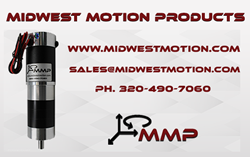Robot Delivery: New Tests in Japan
AN OPEN LETTER TO THE UNITED NATIONS CONVENTION ON CERTAIN CONVENTIONAL WEAPONS
Machine gun-toting drone threatens to change combat forever
New Robotics Lab Allows Anyone to Control the Machines
Robotic Hospitals
Education in Robotic Surgery
A robotic technology stack aimed at developers on a budget
Interview with Shell Ocean Discovery XPRIZE Team Eauligo
Interview with Shell Ocean Discovery XPRIZE Team ARGGONAUTS
ROBO, The First Robotics & Automation ETF, Hits $1 Billion in Assets Under Management
How Robots Using Amazon Alexa Could Help Injured People Be More Mobile at Home
Robotic Welding 101
Why Co-Parenting With Telepresence Robots Could Be a Fantastic Idea
Edge Following
Robotics, artificial intelligence fund has tripled the Dow this year
Records 2206 to 2220 of 3741
First | Previous | Next | Last
Featured Product

Midwest Motion Products is a leading provider of robust and reliable Motion Control Products.
Robotics and Automation - Featured Company

